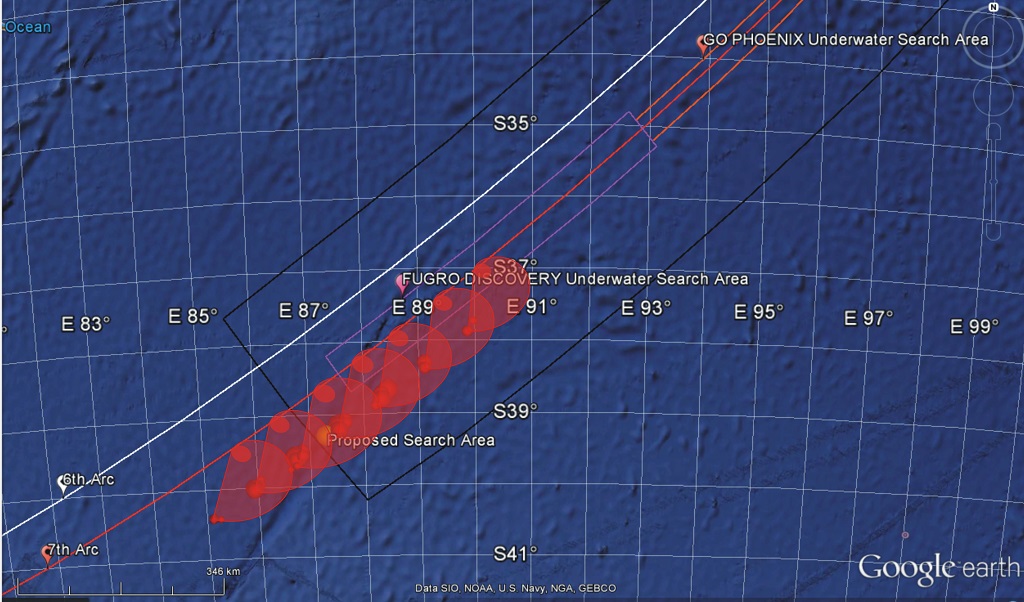Octavian Thor Pleter and Cristian Emil Constantinescu, and Barna Istvan Jakab, University Politehnica of Bucharest, 060042 Bucharest, Romania
Abstract: In the aftermath of the disappearance of the Malaysian 370 (MH370) flight in March 2014, new positioning methods were employed to establish the search area. In the absence of all other positioning technologies (Transponder, Radio communications, Radar), these innovative methods are based on the handshake signals between an INMARSAT satellite and the satellite transceiver on board the aircraft. The log of these signals was made public in order for the scientific community to engage in solving the mystery of the MH370 trajectory. The log indicates the delay between the interrogation and response signals, as well as the relative velocity indications, based on the shift of the carrier frequency due to the Doppler-Fizeau effect. This paper puts forward an original, independent and accurate positioning method and allows the calculation of the MH370 trajectory considering the wind vector field that day, the accurate satellite orbit and an accurate model of the Earth (the WGS-84 ellipsoid). The results were compared to other results published, indicating a different final position of the aircraft from the locations of the published search area.
Download full article here.
The article won the Richey Medal 2017 of the Royal Institute of Navigation, London.
Eliberarea actelor de studii pentru absolventii promotiei 2023 (licenta si master).
Incepand cu data de 10.06.2024 se va proceda la eliberarea actelor de studii si pentru absolventii promotiei 2023 (licenta si master). Ridicarea actelor de studii se va face de la Biroul Acte de Studii, situat in cladirea Rectorat, Camera 307. Programul de eliberare...
Tabere studențești de vară – 2024
<< Rezultate finale tabere vara >> Calendar burse studentesti Inscrierea pentru tabara studenteasca de vara se face pana pe data de 11.07.2024, ora 16:00. Listele candidatilor selectati vor fi afisate pe data de 11.07.2024. depunerea contestatiilor se vor...
Free official English language testing through the British Council
From the academic year 2022/2023, our university, in partnership with the British Council, is offering students the opportunity to have their English language skills officially tested free of charge. For this academic semester the tests available are: Aptis ESOL...
Testare oficiala a cunostintelor de limba engleza prin British Council in mod gratuit
Începând cu anul academic 2022/2023, universitatea noastră, în parteneriat cu British Council, oferă studenților posibilitatea testării oficiale a cunoștințelor de limba engleză, în mod gratuit. Pentru acest semestru universitar testele disponibile sunt: Aptis ESOL...
Space Academy
Sesiunea de Comunicări Științifice Studențești 2024
Vă invităm să participați la „Sesiunea de Comunicări Științifice Studențești” care va avea loc pe 10 mai. Pentru a participa, este necesar să vă înscrieți până pe 18 aprilie, ora 14:00, prin trimiterea unui e-mail la adresa valentin.pana@upb.ro. Dacă aveți un profesor...
Acte lipsa ale studentilor masteranzi din anul II 2024
Acte lipsa ale studentilor masteranzi MA Acte lipsa ale studentilor masteranzi SHS Acte lipsa ale studentilor masteranzi PAPM Acte lipsa ale studentilor masteranzi GID
AeroConnectMeetings
În data de 2 martie 2024 a avut loc AeroConnectMeetings, un eveniment dedicat ingineriei Aerospațiale prin care studenții de la Facultatea de Ingnerie Aerospațială au avut posibilitatea de a...
Echivalarea modulelor PART66
În urma demersului făcut către Autoritatea Aeronautică Civilă Română, şi a recunoaşterii conţinutului curicular la unele discipline predate la Facultatea de Inginerie Aerospaţială, UNSTPB, în raport cu cerinţele prevăzute la modulele din Anexa III, PART 66, a...
<< Concurs pentru postul de director Departamentul de Ingineria Sistemelor Aeronautice și Management Aeronautic ”Nicolae Tipei” 2024-2029 >>
Depunerea dosarului pentru concursul de director de departament se va face pana la data de 21.02.2024, ora 16:00, la secretariatul departamentului. Sedinta de alegere a directorului de departament va avea loc in data de 27.02.2024, ora 14:00, la secretariatul...


0 Comentarii